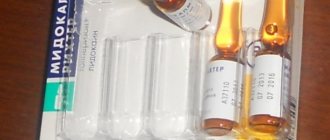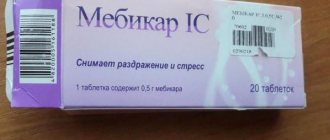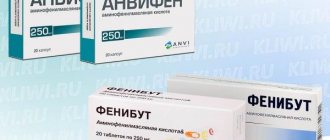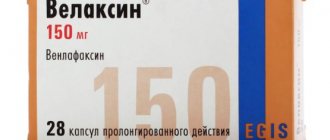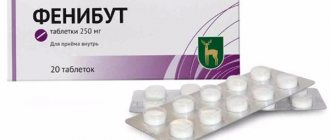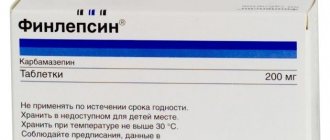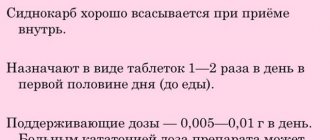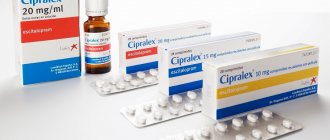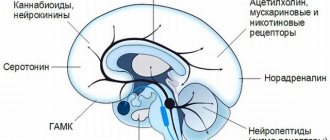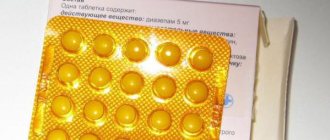| Phenazepam | |
| Phenazepamum | |
| Phenazepam | |
| Chemical compound | |
| IUPAC | 7-bromo-5-(ortho-chlorophenyl)-2,3-dihydro-1H-1,4-benzodiazepin-2-one |
| Gross formula | C₁₅H₁₀BrClN₂O |
| Molar mass | 349.609 g/mol |
| CAS | 51753-57-2 |
| PubChem | 40113 |
| Classification | |
| ATX | N05BX |
| Pharmacokinetics | |
| Metabolism | liver |
| Half-life | 18 hours |
| Excretion | kidneys |
| Dosage forms | |
| solution for intravenous and intramuscular administration, tablets | |
| Other names | |
| "Phenazepam", "Phenorelaxan", "Fesipam", "Elzepam", "Fenzitat" | |
| Phenazepam on Wikimedia Commons | |
Phenazepam
(active ingredient -
bromodihydrochlorophenylbenzodiazepine
) is a drug from the benzodiazepine group with tranquilizing (anxiolytic), anticonvulsant, hypnotic, muscle relaxant and sedative effects [1]. White or white with a creamy tint crystalline powder, practically insoluble in water, slightly soluble in alcohol, ether, chloroform, soluble in toluene, benzene, dioxane, dimethylformamide [2].
Content
- 1 History of the creation of the drug
- 2 Receipt
- 3 General information
- 4 Pharmacokinetics
- 5 Indications
- 6 Mechanism of action
- 7 Contraindications
- 8 Side effects 8.1 Correction of side effects
- 14.1 By country
Safe dose of phenazepam
Phenazepam is a “complex” drug that must be taken with caution. It is undesirable to exceed the recommended dosages of phenazepam, so as not to provoke poisoning, side effects, addiction and drug dependence.
Doses of phenazepam according to instructions
We will talk about tablets, since the drug in ampoules is used only in medical institutions. In an informational article for a wide range of readers, such diversions would be inappropriate.
For insomnia, the drug is prescribed in a dose of 0.5 mg 40-60 minutes before bedtime;
Neuroses and psychoses require the drug to be prescribed in a dosage of 0.5-1 mg 2-3 times a day. Depending on the effect, it may be increased;
For fear and anxiety (which can also be accompanied by sleep disturbances), the daily dose of phenazepam for a person is 3 mg, followed by an increase;
Treatment of epilepsy and withdrawal syndrome requires even higher dosages;
The maximum dose of phenazepam per day is 10 mg.
What affects the dose of the drug?
If you read the instructions for the drug, you will understand why you should limit the dosage of sleeping pills. It has a lot of negative side effects and contraindications, it is addictive and addictive. But what if the usual dose of phenazepam does not work?
Decide why this is happening.
1. Different people have different sensitivity to the drug.
Its effectiveness does not depend on body weight or age, it’s all about sensitivity to the active substance. Sometimes it happens that a person with insomnia is not affected by the dosage prescribed by the doctor. This is usually noticeable from the very beginning of treatment.
2. Over time, addiction develops.
Another situation: at first phenazepam helped, but then stopped. The body begins to require a larger dose of phenazepam in order to have any effect! When taking pills regularly, addiction inevitably occurs. The sensitivity of the receptors that perceive the drug decreases, and so does the effect of standard doses.
How to choose a dose so that there are no consequences
1. Take the drug only as directed by your doctor.
Hopefully you know this by default. Only a doctor understands all the details of your condition, knows what initial dose to prescribe, whether it should be increased and by how much.
2. Increase the dosage gradually.
If a person takes phenazepam for insomnia, he should not have this situation: he took a pill, did not see the effect, took one or two more. The dosage is increased according to the doctor’s recommendation and gradually, not abruptly!
3. You cannot take phenazepam constantly.
The permissible duration of treatment is 2 weeks. In rare cases, the reception is longer. But it is optimal to take any sleeping pill as needed (occasionally) and no more than 8 times a month.
If you feel that you will fall asleep on your own, you should not take phenazepam as a means of preventing insomnia. Try to restrain yourself! This will slow down the decrease in sensitivity to the drug and prevent addiction from developing.
4. Be prepared to stop taking the drug.
There is no need to get attached to pills. You should not allow yourself to believe that they are necessary for your sleep, and without them you will not fall asleep. It is easy to develop dependence on phenazepam; there is no need to encourage it with constant replenishment of supplies, and there is no need to keep the drug on the nightstand all the time. Think of it simply as a temporary relief from which you can move away at any time.
5. Make sure that it is phenazepam you need.
Many people take the drug without indications. Especially those who use it for sleep. It must be remembered that sleeping pills do not fight the cause of insomnia, which means they simply suppress the symptom, but do not eliminate the problem.
The only drug that eliminates the cause of insomnia is Melaxen. It contains the sleep hormone melatonin, helps restore sleep and restore rhythms in circadian insomnia (sleep disorders caused by improper sleep patterns).
The drug is very effective for insomnia due to a shift schedule, time zone changes or disturbances in sleep patterns on weekends. It helps from the first days, is not addictive or dependent, and is sold in pharmacies without a prescription.
History of the drug's creation
Phenazepam is the first benzodiazepine tranquilizer created in the USSR.
In the early 1970s, a group of scientists led by V.V. Zakusov received a state order to create a domestic tranquilizer. The molecule was synthesized at the Odessa Physicochemical Institute of the Ukrainian SSR Academy of Sciences (S. A. Andronati and A. V. Bogatsky) [3]. The names of many other prominent scientists are associated with the development of phenazepam - S. B. Seredenin and T. A. Voronina (pharmacological screening, selection and study), G. Ya. Avrutsky and Yu. A. Aleksandrovsky (clinical efficacy and safety).
For its receipt (1974), implementation (1978) and creation of the scientific basis of a new branch of military medicine (military psychopharmacology) to a group of Soviet scientists - G. Ya. Avrutsky, Yu. A. Aleksandrovsky, S. A. Andronati, A. V. Bogatsky , Yu. I. Vikhlyaev, T. A. Voronina, V. V. Zakusov, A. L. Zyuban, B. V. Ovchinnikov, S. B. Seredenin, L. I. Spivak, G. V. Chuchkin - awarded USSR State Prize (1980).[4][5]
Detoxification in hospital
In the hospital, first of all, gastric lavage is performed using a siphon. In this way, you can cleanse the entire stomach without artificially stimulating the vomiting center. After gastric lavage, sorbents (activated carbon, Smecta, white carbon) may be prescribed.
Instead of drinking plenty of fluids in the hospital, infusion therapy with 5% glucose and saline is carried out. This helps remove drug toxins from the liver and kidneys. This way, cleansing occurs faster and symptoms of poisoning or overdose disappear.
The next step is to prescribe specific antidotes to benzodiazepines. These are the following:
- Mesocarb;
- Flumazenil.
Both drugs must be calculated correctly. If the dosage is incorrect, it can only make things worse.
If possible, in a hospital or special rehabilitation clinics, the blood is purified using an “artificial kidney” device, and the patient is sent for hemodialysis. All methods are based on hardware blood purification; they are relevant for detoxification. Although there is evidence that in case of an overdose of Phenazepam, hemodialysis is ineffective.
It has been established that among all drugs from the benzoidazepine group, Phenazepam is one of the best anxiolytics.
Taken from the scientific article: “The effectiveness of phenazepam as part of complex therapy in patients with anxiety-depressive syndromes.” Authors: M.E. Statsenko, O.E. Sporova, O.A. Talker.
Receipt
Synthesis scheme according to the method of S. A. Andronati, A. V. Bogatsky and Yu. I. Vikhlyaev, developed at the Physico-Chemical Institute of the Academy of Sciences of the Ukrainian SSR [3]:
First, 2-(o-chlorobenzoylamino)-5-bromo-2-chlorobenzophenone is obtained by acylation of p-bromoaniline with o-chlorobenzoic acid chloride in the presence of a catalyst - zinc chloride. 2-(o-chlorobenzoylamino)-5-bromo-2-chlorobenzophenone is hydrolyzed with aqueous sulfuric acid to give 2-amino-5-bromo-2-chlorobenzophone. 2-amino-5-bromo-2-chlorobenzophone is acylated with aminoacetic acid chloride hydrochloride in chloroform. Then 2-(aminomethylcabronylamino)-5-bromo-2-chlorobenzophenone hydrochloride is formed, which is converted into a base with aqueous ammonia and then thermally cyclized to bromodihydrochlorophenylbenzodiazepine
[2].
Aminoacetic acid chloride hydrochloride is prepared by treating aminoacetic acid with phosphorus(V) chloride in chloroform.
general information
Phenazepam is a highly active tranquilizer. The strength of the tranquilizing and anxiolytic (anti-anxiety) action is superior to other benzodiazepine and abenzodiazepine tranquilizers[6]; It also has a pronounced anticonvulsant, muscle relaxant (muscle relaxant) and hypnotic effect. It is superior to diazepam in its anti-anxiety and hypnotic effects [7]. The strength of the hypnotic effect is close to nitrazepam[1]. When used together with hypnotic and opioid drugs, there is a mutual enhancement of the inhibitory effect on the central nervous system.
Interaction with other drugs
When taking Phenazepam simultaneously with Levodopa, the effectiveness of the latter drug is reduced.
An enhanced effect is observed when taken simultaneously with antipsychotics, hypnotics, as well as alcohol, narcotic analgesics and central muscle relaxants.
The likelihood of development and severity of toxic effects increases if Phenazepam is combined with inhibitors of microsomal liver enzymes.
The drug may increase the effectiveness of antihypertensive drugs.
Indications
Phenazepam is prescribed:
- for various neurotic, neurosis-like, psychopathic and psychopath-like conditions, accompanied by anxiety, fear, increased irritability, emotional lability [1].
- for obsession, phobia, hypochondriacal syndromes, including hypochondriacal-senestopathic (including those resistant to the action of other tranquilizers); for phobias and obsessions, they are especially effective in combination with perphenazine (etaperazine) and trifluoperazine (triftazine) [8],
- for psychogenic psychoses, panic reactions, etc., as it relieves anxiety and fear[1],
- for the relief (relief) of alcohol withdrawal[1] and alcoholic delirium (a condition resulting from a sudden cessation of alcohol intake that occurs at stages II-III of alcoholism)[9],
- as an anticonvulsant (mainly for local, small, abortive seizures)[8], also for the treatment of patients with temporal lobe epilepsy and myoclonic epilepsy[10],
- as a sleeping pill,
- for premedication in preparation for surgical operations[11],
- for the prevention of emotional stress and states of fear[10],
- for the treatment of hyperkinesis and nervous tics[10],
- with muscle stiffness[10],
- for autonomic dysfunctions and autonomic lability [10].
- reduces affective tension in delusional disorders.
In combinations:
- for severe psychomotor agitation in manic or psychotic patients (in combination with antipsychotics and lithium salts) [12]: 724.
Phenazepam and strong alcohol in one bottle are life-threatening
These two products are not compatible, and therefore mixing them is strictly prohibited. If you still take Phenazepam and strong alcohol at the same time, the tranquilizing effect of the medication will be enhanced. The person will experience unreasonable fear, his reaction will become inhibited, hallucinations will begin, and his consciousness will become cloudy.
Much depends on a person’s individual tolerance to Phenazepam with alcohol. Some may experience shortness of breath, while others may immediately fall into a coma. Many people risk falling asleep for a long time, and the sleep will be accompanied by attacks of suffocation, which can be fatal. For this reason, doctors strongly recommend never mixing Phenazepam with alcohol.
Mechanism of action
Increases the inhibitory effect of gamma-aminobutyric acid (GABA) on the transmission of nerve impulses[13]. Stimulates BD receptors (in the allosteric center, etc.)[13].
Inhibits polysynaptic spinal reflexes, reduces the excitability of subcortical structures of the brain (thalamus, hypothalamus and limbic system)[13].
The anti-anxiety effect is due to the influence on the amygdala complex of the limbic system [13]. This effect reduces anxiety, fear, restlessness and emotional stress.
The sedative effect is associated with the influence on the nonspecific nuclei of the thalamus and the reticular formation of the brain stem [13]. In particular, this effect also reduces symptoms of neurotic origin, fear and anxiety [13].
The hypnotic effect is associated with inhibition of the cells of the reticular formation of the brain stem. Phenazepam reduces the impact of vegetative, emotional, motor (motor) stimuli that can disrupt the sleep mechanism, and helps to fall asleep faster.
The anticonvulsant effect occurs due to increased presynaptic inhibition. The excited state of the focus (excited nervous structure or group of neurons) does not eliminate, but the spread of the convulsive impulse is suppressed.
The central muscle relaxant effect occurs due to inhibition of both monosynaptic (to a small extent) and polysynaptic spinal afferent inhibitory pathways. Direct inhibition of muscle and motor nerve function is also likely to occur.
Overdose
An overdose of Phenazepam most often occurs for three reasons: an overdose when increasing the dose on your own, when trying to get drug intoxicated, and when attempting suicide.
An overdose always occurs. This is due to the fact that with each subsequent dose of the drug, receptor insensitivity to its active substances occurs. This process is called the development of tolerance. That is, with each subsequent reception the severity of the effects is less, and they end faster.
If help is not provided in time, a person may die from respiratory failure or cardiac arrest.
How to recognize and what to do
In case of an overdose of any drug from the group of tranquilizers, the following symptoms will immediately appear:
- depression and confusion;
- decreased blood pressure;
- slowing and stopping of the heart;
- slowing and stopping breathing;
- nystagmus;
- convulsions or tremors of the limbs;
- decreased response to tendon reflexes.
With such symptoms, a coma develops, and the person dies without treatment. The main help is gastric lavage, taking sorbents and intravenous administration of a specific antidote: flumazenil.
If necessary, artificial respiration and chest compressions must be performed before the ambulance arrives. You need to press on the chest at intervals of 2 times in 1 second. You need to inhale air into the person’s mouth or nose every 30 presses.
Rehabilitation
Considering that physical dependence on Phenazepam practically does not develop, the main task of rehabilitation is the psychological restoration of the individual, programming a new style of behavior, the patient’s adaptation to society and working with codependent people.
In complex addiction therapy, the location where rehabilitation is carried out plays a role. As a rule, at home or with friends, any attempts to quit end with taking the same drugs or other drugs with a similar effect.
Antidepressive therapy is sometimes added to the rehabilitation complex. With the right dosage, this is a good technique that allows you to get rid of the consequences of depletion of your own mediators.
Coding
Coding doesn't work with dependencies. More than 1000 studies have shown that this method has no evidence base and its use is not rational. Therefore, we can conclude that specialists engage in coding solely for personal gain. The best method of treatment is the correct rehabilitation complex. Coding, hypnosis and similar methods do not work.
Why not at home or on an outpatient basis?
With abrupt withdrawal of Phenazepam, rebound syndrome occurs. This means that without the drug, all the processes that were inhibited by the drug will become 3-4 times more intense. This leads to convulsions and even loss of consciousness. Therefore, you need to quit gradually, under the control of tests and after consultation with a specialist.
In an outpatient setting, it is very difficult to monitor whether the patient is complying with the rehabilitation program. At home, there are no barriers or incentives that force you to stop using drugs. In addition, home conditions mean constant contact with possible active drug addicts. If communication is not stopped, the person will not leave on his own.
Another disadvantage of home rehabilitation is the presence of constant conflicts with family members. Conflict situations become reasons for relapse or even switching to harder drugs.
The only option for outpatient treatment is when a person has been using for 1-2 months and the dependence is mild.
Working with codependents and resocialization
Resocialization is a person’s path to a new social life. Without restoration of the social role, a breakdown may occur. Addicted addicts need constant communication, work for distraction and emotional return from friends, colleagues, and family members. This way a person will realize that he has something to live for and limit himself from drugs.
If this is not done, after a short period of time a breakdown may occur due to melancholy or depression. These are frequent cases, and they are dangerous because after the next breakdown it becomes increasingly difficult to achieve remission in addiction.
In order to minimize disruptions, they work with codependent people, that is, loved ones and family members. During such work, codependent people learn how to correctly shape their behavior and how to help the patient quit drug use forever.
Only close people have constant contact with the addict. They should play the role of psychologists with whom the patient can share his experiences without keeping anything to himself. This minimizes the risk of disruption and restores harmonious relationships between family members. Therefore, without working with codependents, rehabilitation is considered incomplete.
How to quit on your own
You really have to want it. If I quit, then immediately without such excuses: starting Monday, tomorrow, the last time, I’ll quit. In the case of drugs, the reservations do not apply. You need to be prepared for withdrawal, during which there will be a strong desire to use the drug, and without use, depression and even suicidal thoughts may appear.
It is necessary to limit contact with anyone who is an active drug addict, even if they are taking other substances or medications. Such people are a constant temptation to relapse. You cannot change one drug for another because you will end up dependent on two drugs.
It is necessary to monitor health indicators, liver and kidney function. Your attending physician will tell you about the regularity of liver tests and creatinine clearance. In any case, treating addiction on your own is difficult and dangerous. If possible, it is always better to consult with specialists in the field of addiction.
Contraindications
Hypersensitivity (including to other benzodiazepines), coma, shock, myasthenia gravis, angle-closure glaucoma (acute attack or predisposition), acute alcohol poisoning (with weakening of vital functions), narcotic analgesics and hypnotics, severe chronic obstructive pulmonary disease (possibly increased respiratory failure), acute respiratory failure, severe depression (suicidal tendencies may occur) [ source not specified 331 days
]; pregnancy (especially the first trimester), lactation period, age under 18 years (safety and effectiveness have not been determined).
With caution. Hepatic and/or renal failure, cerebral and spinal ataxia, history of drug dependence, tendency to substance abuse, hyperkinesis, organic brain diseases, psychosis (paradoxical reactions are possible), hypoproteinemia, sleep apnea (established or suspected), old age.
special instructions
If a tranquilizer is prescribed to a patient with liver and/or kidney dysfunction, then during the treatment course periodic monitoring of peripheral blood and liver enzyme activity is necessary.
- If a drug is used for the first time, then the patient may experience a therapeutic effect even when using minimal dosages. Therefore, for this category of people, the amount of the drug should be selected most carefully.
- Like other benzodiazepine substances, an anxiolytic can cause drug dependence (with a long course or use of a large amount of drugs), and with a sharp interruption of therapy or a strong reduction in dosage, withdrawal syndrome. If you suspect these phenomena, you need to contact your doctors to coordinate treatment or discontinue the drug.
- During therapy, you should absolutely not take alcohol or ethanol-containing medications.
- The drug is extremely undesirable for use in pediatrics (under 18 years of age), since there is not enough convincing information about the safety and effectiveness of the drug.
During the therapeutic period, increased caution should be exercised when engaging in hazardous activities, as well as when driving vehicles or complex mechanisms that require high instant reaction and concentration.
Side effects
| This section is missing references to information sources. Information must be verifiable, otherwise it may be questioned and deleted. You may edit this article to include links to authoritative sources. This mark was set on November 21, 2020 . |
From the central nervous system and peripheral nervous system: at the beginning of treatment (especially in elderly patients) - drowsiness, fatigue, dizziness, decreased ability to concentrate, ataxia, disorientation, unsteady gait, slowed mental and motor reactions, confusion; rarely - headache, euphoria, depression, tremor, memory loss, impaired coordination of movements (especially at high doses), depressed mood, dystonic extrapyramidal reactions (uncontrolled movements, including the eyes), asthenia, myasthenia, dysarthria, epileptic seizures (in patients with epilepsy); extremely rarely - paradoxical reactions (aggressive outbursts, psychomotor agitation, fear, suicidal tendencies, muscle spasms, hallucinations, agitation, irritability, anxiety, insomnia).
From the hematopoietic organs: leukopenia, neutropenia, agranulocytosis (chills, hyperthermia, sore throat, excessive fatigue or weakness), anemia, thrombocytopenia.
From the digestive system: dry mouth or drooling, heartburn, nausea, vomiting, loss of appetite, constipation or diarrhea; liver dysfunction, increased activity of “liver” transaminases and jaundice. From the genitourinary system: urinary incontinence, urinary retention, renal dysfunction, decreased or increased libido, dysmenorrhea.
Allergic reactions: skin rash, itching.
Effect on the fetus: teratogenicity (especially the first trimester), central nervous system depression, respiratory impairment and suppression of the sucking reflex in newborns whose mothers used the drug. Local reactions: phlebitis or venous thrombosis (redness, swelling or pain at the injection site).
Other: addiction, drug dependence; decrease in blood pressure; rarely - visual impairment (diplopia), weight loss, tachycardia.
With a sharp reduction in dose or cessation of use - withdrawal syndrome (irritability, nervousness, sleep disturbances, dysphoria, spasm of smooth muscles of internal organs and skeletal muscles, depersonalization, increased sweating, depression, nausea, vomiting, tremor, perception disorders, including hyperacusis, paresthesia, photophobia; tachycardia, convulsions, rarely - acute psychosis).
Correction of side effects
Mesocarb (Sidnocarb), as well as the specific benzodiazepine receptor antagonist flumazenil, are effective as a corrector that reduces or removes the side effects of phenazepam [1].
How long does it stay in the body?
The rate of elimination from the body depends on the ability of the liver to process the components of the drug. On average, tranquilizers are eliminated in 3-5 days. But the exact period depends on both the period of use and the age of the addict.
It is necessary to consider whether it was taken together with other drugs or alcohol. All this slows down the functioning of internal organs and leads to a slower elimination of the drug from the body.
Phenazepam is excreted through the kidneys, so the best method is to test your urine. Metabolites of the drug can be found in urine within 3-4 days. In the blood - 12-18 hours. There are no other data on hair or saliva testing for Phenazepam.
Get help now
Do any of your relatives or friends have an addiction? Have you tried in every possible way to help, but as a result the person still returned to his past life?
You are not the first to encounter this problem, and we can help you.
We guarantee anonymity, we will persuade you to undergo treatment, and we will help you choose a center.
Call us
+7
or
Call me
Application, dosage
Phenazepam is prescribed orally in tablet form. On an outpatient basis, adults are prescribed 0.00025-0.0005 g (0.25-0.5 mg) 2-3 times a day[1]. In a hospital setting, the daily dose can be increased to 0.003-0.005 g (3-5 mg) [1]; in the treatment of epilepsy, the daily dose ranges from 0.002 to 0.01 g (2-10 mg)[1].
To relieve alcohol withdrawal, 0.0025-0.005 g (2.5-5 mg) per day is prescribed[1]. For sleep disorders, take 0.00025-0.001 g (0.25-1 mg) 20-30 minutes before bedtime[1]. Sometimes the dose is increased to 0.0025 g (2.5 mg)[1]. The maximum daily dose should not exceed 0.01 g[1].
In the treatment of depersonalization, phenazepam is prescribed in large (4-8 mg) and very large (up to 20 mg) daily doses, which is explained by the fact that patients with depersonalization are resistant not only to the therapeutic effect of benzodiazepines, but also to their side effects [14]
For the treatment of mild anxiety during long-term therapy - 0.5-3 mg per day, for severe anxiety (maximum doses) - 3-10 mg[12]:726.
How to take Phenazepam
The drug is indicated for use in various pathological conditions. It is used in the treatment of people over 18 years of age with symptoms of schizophrenia, panic attacks and psychosis. The treatment regimen for insomnia with Phenazepam involves taking 0.25 mg (half a tablet) half an hour before bedtime. After this, you should immediately go to bed. If the effect turns out to be weak over several days, then the dosage is doubled.
After the tablet is taken, it is strongly recommended not to sit at the computer or watch TV. Also, you should not perform other manipulations that stimulate the central nervous system and reduce the effect of the medication.
Legal status
By country
In Russia, phenazepam is permitted and is not included in the list of restricted psychotropic substances (unlike some other benzodiazepines that are in List III: diazepam, clonazepam, lorazepam, etc.).
In Ukraine, in accordance with Resolution of the Cabinet of Ministers of Ukraine dated May 6, 2000 No. 770, phenazepam belongs to List II of the list of narcotic drugs, psychotropic substances and precursors, the circulation of which is limited on the territory of Ukraine and in respect of which exceptions to certain control measures are allowed[16].
In the United States, phenazepam is not approved by the Food and Drug Administration, so it is prohibited from sale as a drug, but it is also not included in the list of controlled substances[17].
In Germany, phenazepam is in Schedule III (German: Anlage III), and the sale and possession of this drug without a prescription is considered illegal[18]. The drug can be prescribed by doctors, but a special prescription form is required.
UN and WHO decisions
On March 18, 2020, it was included in the list of substances subject to special control by the UN Commission on Narcotic Drugs[19]. The WHO Committee recommended the addition of phenazepam to Schedule IV of the 1971 Convention on Psychotropic Substances[20].
Import into customs territory
Phenazepam is listed in the annex to the Decision of the Board of the Eurasian Economic Commission “On non-tariff regulation measures” in the list of the section “Narcotic drugs, psychotropic substances and their precursors” in the list of goods for which a permitting procedure has been established for import into the customs territory of the Eurasian Economic Union and/or export from the customs territory of the Eurasian Economic Union[21]. This means that the drug is necessarily subject to customs declaration; failure to declare phenazepam at customs is an administrative offense under Article 16.2 Part 1 of the Code of Administrative Offenses of the Russian Federation.
Release form and composition
The drug Phenazepam is available in the form of tablets for oral administration in dosages of 500 mcg, 1 mg and 2.5 mg.
The tablets are white, flat-cylindrical, scored on one side. The tablets are packaged in blister packs of 10 pieces and 25 pieces in a cardboard box; the tablets are accompanied by an annotation with a detailed description of the characteristics.
Each tablet contains the active ingredient Phenazepam in a dosage of 500 mcg, 1 mg, 2.5 mg, respectively. The auxiliary components are: potato starch, talc, lactose, povidone, calcium stearate.
The solution for intramuscular and intravenous injection is available in glass ampoules with a capacity of 1 ml. Package:
- cardboard box with 10 ampoules of Phenazepam and scarifier;
- contour blister packaging made of PVC film with 5 or 10 ampoules of the drug.
The cardboard pack is equipped with one or two packages, a scarifier and instructions for using the drug.
1 ml of Phenazepam in ampoules contains:
- 0.001 g phenazepam (bromodihydrochlorophenylbenzodiazepine);
- low molecular weight medical polyvinylpyrrolidone (povidone);
- distilled glycerin (glycerol);
- sodium disulfite (sodium pyrosulfite);
- polysorbate 80 (Tween 80);
- sodium hydroxide solution (caustic soda) 1 M;
- water for injections.


